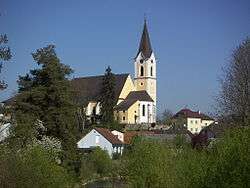Sankt Georgen an der Gusen
| Sankt Georgen an der Gusen | ||
|---|---|---|
 | ||
| ||
 Sankt Georgen an der Gusen Location within Austria | ||
| Coordinates: 48°16′18″N 14°26′54″E / 48.27167°N 14.44833°ECoordinates: 48°16′18″N 14°26′54″E / 48.27167°N 14.44833°E | ||
| Country | Austria | |
| State | Upper Austria | |
| District | Perg | |
| Government | ||
| • Mayor | Erich Wahl (SPÖ) | |
| Area | ||
| • Total | 7.09 km2 (2.74 sq mi) | |
| Elevation | 262 m (860 ft) | |
| Population (1 January 2014)[1] | ||
| • Total | 3,739 | |
| • Density | 530/km2 (1,400/sq mi) | |
| Time zone | CET (UTC+1) | |
| • Summer (DST) | CEST (UTC+2) | |
| Postal codes | 4222, 4223 | |
| Area code | 07237 | |
| Vehicle registration | PE | |
| Website | www.st-georgen-gusen.at | |
Sankt Georgen an der Gusen (also St. Georgen an der Gusen, lit.: Saint George's Town on the Gusen River) is a small market town in Upper Austria, Austria, between the municipalities of Luftenberg and Langenstein. As of 2015, the town had 3,779 inhabitants.
History
During World War II the town was selected to be the DEST-business administration center for exploiting the slave labour in the quarries and later the industries of the Mauthausen-Gusen concentration camp system. In early 1944 the town became the site of Gusen 2 - the most brutal sub-camp of the Mauthausen-Gusen concentration camp system. In roughly 40.000 m² of tunnels and caverns dug beneath St. Georgen for the Messerschmitt company a huge and most modern underground assembly plant for Messerschmitt Me 262 fuselages was operated until May 1945 under the code-name B8 Bergkristall - Esche II.[2] In some trials of the Nuremberg Military Tribunal the relatively unknown term St. Georgen granite works was used to prevent the use of locations like Mauthausen or Gusen.
Population
| Historical population | ||
|---|---|---|
| Year | Pop. | ±% |
| 1869 | 1,089 | — |
| 1880 | 1,128 | +3.6% |
| 1890 | 1,129 | +0.1% |
| 1900 | 1,326 | +17.4% |
| 1910 | 1,434 | +8.1% |
| 1923 | 1,324 | −7.7% |
| 1934 | 1,396 | +5.4% |
| 1939 | 1,429 | +2.4% |
| 1951 | 1,795 | +25.6% |
| 1961 | 2,148 | +19.7% |
| 1971 | 2,805 | +30.6% |
| 1981 | 3,093 | +10.3% |
| 1991 | 3,236 | +4.6% |
| 2001 | 3,529 | +9.1% |
| 2010 | 3,619 | +2.6% |
| 2015 | 3,779 | +4.4% |
References
- ↑ Statistik Austria - Bevölkerung zu Jahres- und Quartalsanfang, 2014-01-01.
- ↑ Rudolf A. Haunschmied, Jan-Ruth Mills, Siegi Witzany-Durda: St. Georgen-Gusen-Mauthausen - Concentration Camp Mauthausen Reconsidered. BoD, Norderstedt 2008, ISBN 978-3-8334-7610-5
| Wikimedia Commons has media related to Sankt Georgen an der Gusen. |
